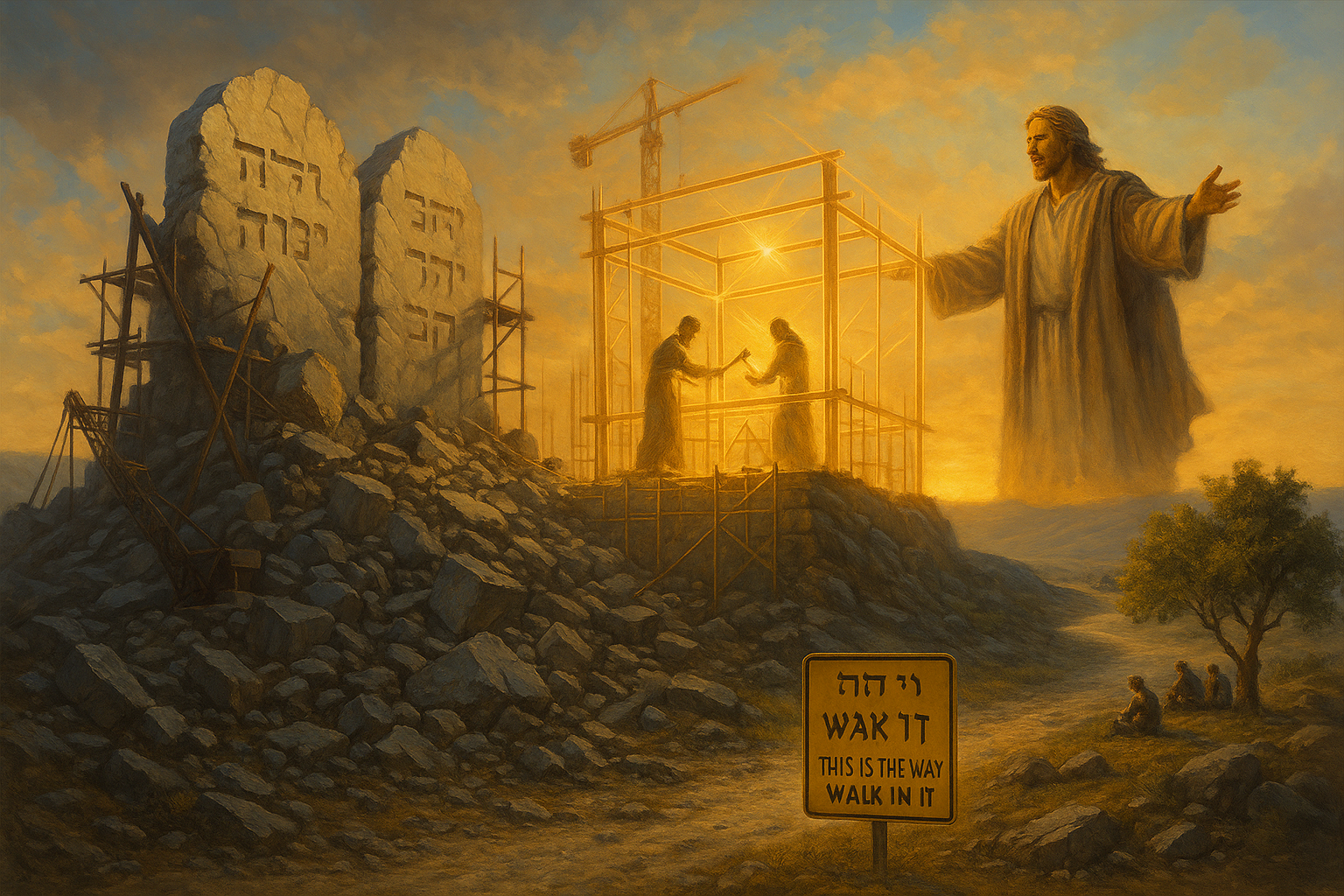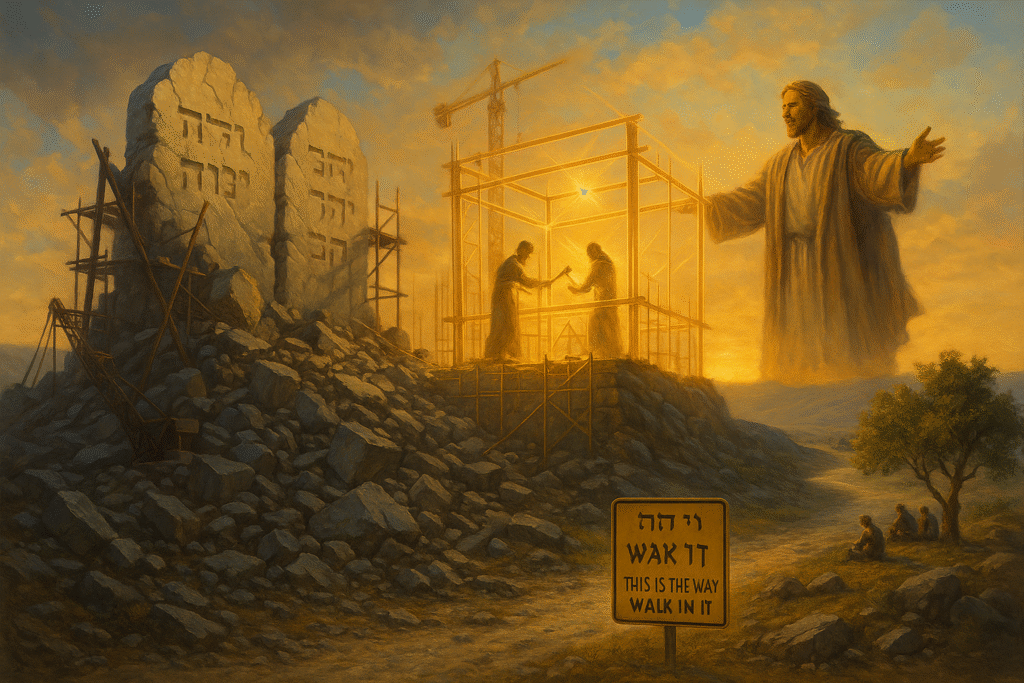Physical Address
304 North Cardinal St.
Dorchester Center, MA 02124
Physical Address
304 North Cardinal St.
Dorchester Center, MA 02124
With Michael Walker
With Michael Walker

To Whom it may concern…..

There are few revelations in the journey of faith that carry the weight of shifting the entire way one reads the Scriptures, perceives God, and walks in covenant. One of those revelations is the realization that God’s instruction is not law—it is love. When this reality is grasped, it produces a peace so profound that it feels as though centuries of distortion are peeled away, and the heavy yoke of misinterpretation is lifted from the shoulders. The entire framework of divine-human relationship is rebuilt on the foundation of affection, guidance, and parental wisdom rather than on cold legality and judicial severity. This is not a small adjustment; it is a complete demolition of a faulty house and the reconstruction of a dwelling built to code, fit to inhabit, safe, and true. For centuries, language barriers, cultural inheritances, and self-righteous traditions have miscast Torah as a legal system when in fact it was always a relational system of instruction. In this deep dive, we will deconstruct how that misunderstanding arose, trace the true meaning of the Hebrew categories, analyze what it means to “break” covenant, expose how pride transformed covenant into legalism, and finally rebuild the proper understanding that instruction is love. We will also examine the indispensable element of waiting as one of the greatest forms of instruction and use analogies to help us see clearly what has too long been twisted.
The problem begins with words, because words shape categories, and categories shape thought. English, with its rigid legal heritage, demands boxes like “law,” “rules,” and “breaking rules.” It does not have the fluid categories of Hebrew, and so it imposes its own. When translators encountered the Hebrew word Torah, which means instruction, guidance, and the way to walk, they forced it into the mold of “law.” This was not innocent; it was shaped by the Greek Septuagint, which rendered Torah as nomos, meaning law, and further hardened by the Latin Vulgate, which used lex. By the time this flowed into English, the pattern was set: Torah was law, plain and simple. Yet Hebrew itself has other words for what we would call law. Mishpatim are judgments, court decisions, rulings in disputes. Chuqim are fixed decrees or statutes. Mitzvot are commands or directives. Dat, borrowed from Persian, means decrees or civil law. Torah, however, is none of these; it is teaching, pointing, guiding, instructing. To equate Torah with law is like confusing a parent’s advice with a police officer’s citation. One seeks to protect and shape you into maturity; the other seeks to punish you for transgression. A child told by a parent, “Don’t touch the hot stove,” is receiving Torah. A criminal told by a judge, “Pay a fine or face jail,” is under law. Collapsing these into one term erases the love of the Father and replaces it with the severity of a court.
Once law language was imposed, it created the next distortion: the notion of “breaking the law.” In Hebrew thought, one does not break instruction, because instruction remains true regardless of obedience. You can ignore it, neglect it, or defy it, but you cannot nullify it. Hebrew has precise verbs for breaking. Parar means to annul or void, specifically used for breaking covenant. Shavar means to shatter, like breaking pottery or bones. Avar means to cross over a line, to transgress. Notice the difference: instruction cannot be broken, but covenant can. Covenant is the agreement that a people makes to walk under instruction. When someone ignores Torah, they have not made Torah void; they have broken their covenant vow. This is a crucial distinction, because translation error produced the familiar phrase “break the law,” which is not Hebraic at all. The law is not shattered by human failure; rather, humans expose their own failure by transgressing what was given in love. It is like a road sign that says “Curve ahead.” One can disregard it and crash, but the instruction remains, untouched. The brokenness lies not in the sign but in the driver’s covenant to obey wisdom.
This leads us to a clearer framework that reconciles what tradition has muddled. Law, in the Hebrew sense, is covenantal terms—the agreed-upon contract of relationship. Torah is the instruction for walking after that covenant is agreed. Covenant itself, berit, is the binding agreement that links the people to their God. The outcome of this arrangement is blessing, flourishing, life, and inheritance. When viewed through this lens, the Father is not a warden enforcing a penal code but a parent laying out terms for relationship, teaching children how to walk, and binding them to promises that lead to life. It is construction, not litigation. Torah is the blueprint, covenant is the signed agreement to build, and the finished house is the blessing of dwelling in security.
So how did this beautiful framework collapse into the legalism that has bound so many? The hinge moment is Sinai. Yahweh offered covenant: “If you will hear My voice and keep My covenant, you will be My treasured possession.” But before the details were even read out, the people shouted three times, “All that Yahweh has spoken, we will do.” It was pride in chorus. It was boasting before understanding. It was a binding oath declared without humility. And almost immediately, they collapsed under its weight, crafting a golden calf at the foot of the mountain. Their vow was premature, their boasting sealed their fate, and Torah was delivered in a way that exposed human weakness. Pride had turned covenant into performance, and performance inevitably became legalism. Later generations, trying to patch the cracks, created fences, added rules, multiplied commands, and enforced them with rigor, thinking God needed human enforcement. Translation into Greek and Latin further codified Torah as statute, and by the time church tradition hardened, legalism was entrenched. What had been instruction in love became control in fear.
At the heart of this disaster lies pride. Pride binds people to what they cannot carry. A boast is a chain around the neck of the speaker. Israel’s threefold shout bound them to instructions they could never keep apart from the Spirit. Pride is like signing a blank contract before the terms are filled in, trusting in one’s own ability rather than waiting on God’s provision. Yahweh, as a loving Father, had no choice but to discipline. Not cruelty, but correction. Not abandonment, but training. He treated Israel as a parent treats a wayward child: chastening them with exile, humbling them with delay, pruning them with consequences. Pride created pressure to perform; Yahweh’s correction exposed the futility of that pride.
The restoration comes when Torah is rightly understood as love, and when waiting is embraced as instruction. Waiting is not a footnote in covenant life; it is central, though often overlooked. The Torah itself does not codify waiting as a single statute, but the entire narrative is soaked with it. Abraham waited decades for Isaac, learning trust in the slow grind of years. Joseph waited in dungeons, learning patience before promotion. Israel waited in the wilderness forty years, their entire generation shaped by delay. David waited years between anointing and enthronement, forged in the fires of pursuit and exile. The disciples themselves were told to wait in Jerusalem until clothed with power. Waiting is not absence; it is instruction by silence. It is the divine classroom where pride is stripped, presumption is exposed, and trust is tested. The Psalms capture this in the refrain: “Wait for Yahweh; be strong and let your heart take courage; yes, wait for Yahweh.” Isaiah captures it in promise: “Those who wait upon Yahweh will renew their strength.” Waiting is not passive—it is obedience. It is one of the clearest forms of Torah because it teaches without words. It is a command with no content except time, yet it may be the most formative command of all. To wait is to align with covenant pace, to resist the urge to grasp prematurely, to accept the Father’s timing. Instruction is love, and waiting is its most profound expression.
Analogies help us see this clearer. Consider the film Bébé’s Kids, where the children are chaotic, rebellious, and boastful. They disrupt every place they go, needing strong parenting, boundaries, and discipline. That was Israel in the wilderness: loud promises, wild behavior, and constant rebellion. Yahweh was the parent strong enough to handle them, refusing to indulge but also refusing to abandon. Or consider parenting itself: good parenting means presence, firm boundaries, consistent consequences, mercy with discipline, protection of dignity, and a long-game approach. That is exactly how Yahweh parents His people. Another analogy can be drawn from memory itself. Classical memory is linear, recording one thing after another. Quantum memory, however, holds states in entanglement, parallel, alive. This is how the Spirit works with revelation: not by storing legal code in dusty books, but by downloading the fullness of truth into the heart at the appointed time. Instruction, then, is not a textbook but a living memory implanted by the Spirit, surfacing exactly when needed.
Practical guardrails are needed if we are to walk in this restored vision. First, do not vow prematurely. Avoid Israel’s error. Speak conditionally, not boastfully. Second, record and test revelations; keep logs, confirmations, and proofs. Third, capture words raw—write them as they come without premature interpretation. Fourth, stay available but not self-bound; be ready without signing blank contracts. Fifth, steward waiting with discipline and humility, treating delay as divine instruction, not divine absence. These guardrails keep covenant life relational rather than legalistic, humble rather than prideful, loving rather than rigid.
In conclusion, we return to the central truth: Torah is not law, it is love. Covenant is not performance, it is trust. Pride turned covenant into legalism, but humility restores its beauty. Waiting is not wasted time, it is the Father’s greatest classroom. Instruction, rightly seen, is the parental voice guiding children into life, not the judge’s gavel condemning criminals. The misinterpretation has gone on too long, and it is time to tear down the crooked scaffolding and rebuild according to the blueprint of love. When we do, the entire house stands firm, the rooms are filled with peace, and the family can flourish within. This is not merely semantics; it is the difference between living under fear and living in love, between trying to uphold statutes by pride and walking in instruction by grace. Torah is love, and love is the only foundation strong enough to hold covenant forever.